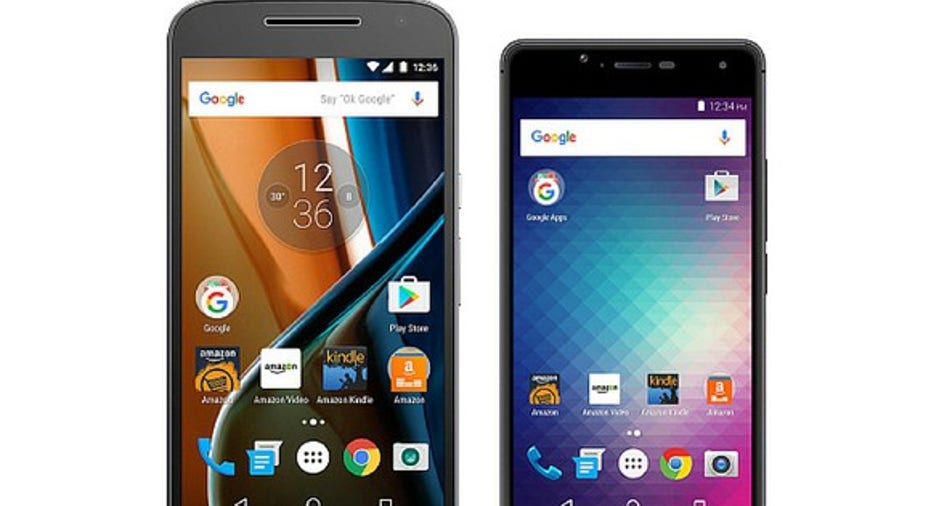Amazon Is Bringing Back Smartphone Subsidies

Image source: Amazon.
The Fire Phone, which Amazon.com released in 2014, ended up being a complete flop. The online retail giant had to write down the product inventory by $170 million just a few months after its release.
Now Amazon is working on a new way to establish a larger presence in the smartphone market. It's offering $50 subsidies on certain Android phones to Prime members. The only catch: Users will have to look at Amazon ads on their lockscreens and a few Amazon apps will come pre-installed. The move offers significantly lower risk for Amazon compared to the Fire Phone, and it mimics a similar strategy employed by Microsoft with a familiar Amazon twist.
The Kindle model
Amazon has had a lot of success selling tablets and e-readers, and subsidizing their prices with lockscreen ads. During the fourth quarter of last year only Apple and Samsung sold more tablets than Amazon. Clearly, a lot of people don't mind seeing Amazon's ads on their tablet lockscreens.
A more personal and more oft-used device like a smartphone might be a different story, though. Apple recently revealed the average iPhone user unlocks his device 80 times per day. On top of that , ads will show up below notifications, which can number in the hundreds per day. That's a lot of ads.
The good news is that Amazon is able to experiment with the subsidy model with very little risk. Amazon may have simply struck a deal with the two manufacturers it's working with (Motorola and BLU) with little to no upfront cost. So, even if no one takes Amazon up on its offer, it's not losing anything.
But it has a whole lot to gain
Amazon will advertise all sorts of different products with its lockscreen ads, many of which are sold by the retailer. Additionally, it will pre-install its flagship shopping app, along with the Prime Instant Video, Prime Music, and Kindle apps. Combined, these subsidized phones have the potential to increase sales on Amazon.com and the usage of other Prime benefits. The latter could help reduce churn for Prime members.
Converting mobile shoppers remains a challenge for the industry as a whole. One of the easiest ways to overcome the challenge is to get customers to install a retailer's mobile app. That allows for smoother checkouts since apps can more easily store login and checkout information. It appears that Amazon thinks it can recoup the $50 it's subsidizing the phones with increased sales thanks to pre-installing its apps.
The mobile commerce market is expanding rapidly. A recent comScore study found that the marketincreased 40% year over year during the first quarter. That's significantly faster than the 11% growth in overall e-commerce. If Amazon can grab an out-sized portion of that mobile commerce growth, it ought to maintain its significant e-commerce lead over its competitors.
A page out of Microsoft's playbook
Amazon isn't the only company partnering with smartphone manufacturers to establish a larger presence on mobile. Microsoft has already partnered with over 70 manufacturers to pre-install its apps and services on smartphones and tablets.
Much like Amazon, Microsoft has tried and failed to sell its own smartphones after acquiring the device segment of Nokia. It's since written down the Nokia acquisition and sold off most of its assets. The software giant is now more focused on getting its services used across every platform from smartphones to tablets to PCs.
While neither Microsoft nor Amazon can achieve the same seamless integration of their services through third-party hardware compared to their own designs, getting their apps pre-installed is far more profitable than ordering a bunch of new devices that just sit on shelves. If it doesn't work out, at least neither will have another major write down.
The article Amazon Is Bringing Back Smartphone Subsidies originally appeared on Fool.com.
Adam Levy owns shares of Amazon.com. The Motley Fool owns shares of and recommends Amazon.com. The Motley Fool owns shares of Microsoft. Try any of our Foolish newsletter services free for 30 days. We Fools may not all hold the same opinions, but we all believe that considering a diverse range of insights makes us better investors. The Motley Fool has a disclosure policy.
Copyright 1995 - 2016 The Motley Fool, LLC. All rights reserved. The Motley Fool has a disclosure policy.



















